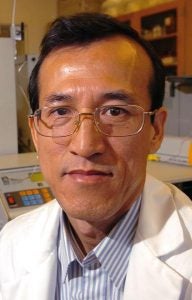ECU chemist’s green research cuts use of toxic organic solvents

Dr. Yu “Frank” Yang
GREENVILLE, N.C. — An East Carolina University professor is working with Procter & Gamble to significantly reduce the use of toxic organic solvents in the chemical analysis of everyday consumer goods.
Dr. Yu “Frank” Yang, a professor in the chemistry department, and his team of student researchers are finding more environmentally-friendly ways to perform quality control tests — methods that could be used for chemical analysis of food, drink, health and beauty products.
As a result, manufacturers like P&G could save money and sharply reduce the amount of hazardous solvents like methanol and acetonitrile used in their analytical laboratories.
“There is a chain of environmental impacts,” Yang said.
P&G, the world’s largest consumer packaged-goods company, gave Yang nearly $80,000 this year to study the industrial application of research that builds upon the work he’s been engaged in since coming to ECU in 1997.
Like many companies, P&G uses high-performance liquid chromatography (HPLC), a technique that separates compounds dissolved in solutions, to test products before they hit store shelves. The organic solvents used in such tests are toxic and must be disposed of carefully.
Yang has been pioneering a way to minimize, even eliminate the use of hazardous organic solvents in HPLC methods. By substituting organic solvents with subcritical water — water that’s heated past the boiling point but below 374 degrees Celsius (705.2 degrees Fahrenheit) and 218 atmospheres of pressure, he’s developed processes that can offer a green alternative.
Yang and his team have developed three methods of “subcritical water chromatography” for P&G. Two work without using any organic solvents. A third cuts their use by more than 50 percent, Yang said.
Now, P&G is in the process of adopting one of the methods that eliminates the organic solvents for analysis of niacinamide — a compound related to Vitamin B3. Once put in place, the measure will improve the company’s environmental impact as well as save money, Yang said.
The basic principles of subcritical water chromatography could be applied to many more existing industrial methods, he said.
“There are hundreds of HPLC methods in the industry and 30 percent of them, my honest opinion is, can be replaced by this green separation technique,” Yang said.
Dr. Rickey Hicks, chair of the chemistry department, said Yang is one of the top few scientists in the world who’s leading the subcritical water research.
“It’s not only an impact on the environment, which will be better off because of this technology, but it also will save companies money,” Hicks said. “It would cut down on the organic solvents that are potential pollutants that could end up in the groundwater, the water supply or as an atmospheric pollution.
“This has the potential to impact all types of chromatography based chemical analysis,” Hicks said. “Chromatography of one type or another is used by every producer of consumer goods around the world, and it is in greater than 75 percent of the research laboratories of the world.”
Yang completed his undergraduate and graduate degrees in China and his doctorate in Germany. In 1997, he joined ECU from the Energy and Environmental Research Center in North Dakota. He has authored 56 peer-reviewed journal articles, reviews and book chapters.
His research team working on the P&G project includes a Ph.D. student, Brahmam Kapalavavi; a master student, Leena Gujjar; and three undergraduate students: Zackary Strickland, Amandeep Gujral, and Samar Hadrous. Yang’s collaborators at P&G are Dr. Ronita Marple and Dr. Chris Gamsky.